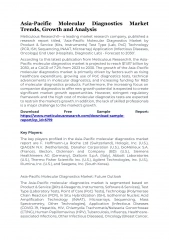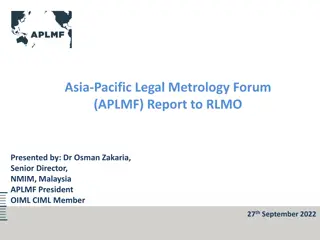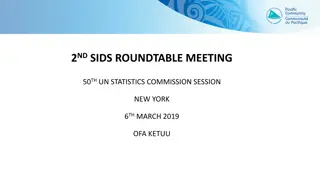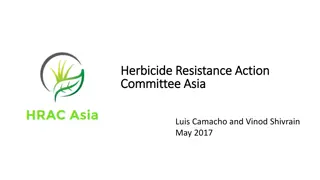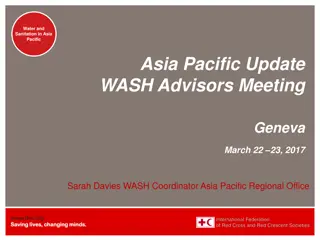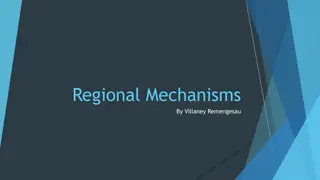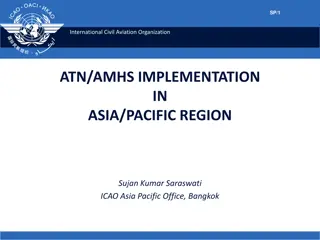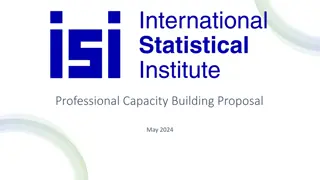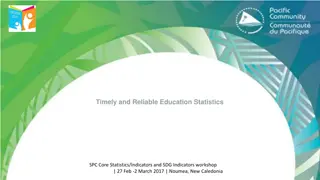Enhancing Economic Statistics in Asia-Pacific Region
The Regional Programme on Economic Statistics aims to improve economic statistics in the Asia-Pacific region by enhancing capacity and coordination among National Statistical Offices (NSOs) and other stakeholders. The programme focuses on implementing the Core Set of Economic Statistics to facilitate better economic analysis and decision-making. By 2020, the goal is to have NSSs in Asia-Pacific capable of producing and disseminating economic statistics in line with international standards.
Download Presentation

Please find below an Image/Link to download the presentation.
The content on the website is provided AS IS for your information and personal use only. It may not be sold, licensed, or shared on other websites without obtaining consent from the author. Download presentation by click this link. If you encounter any issues during the download, it is possible that the publisher has removed the file from their server.
E N D
Presentation Transcript
Regional Programme on Economic Statistics Regional Workshop on Short-term Economic Indicators and Service Statistics 25-27 September 2017 Chiba, Japan
2008 SNA at the global level 2009 Adoption of the 2008 SNA by the UN Statistical Commission 2010 Publication of 2008 SNA in English 2011 Publication of 2008 SNA in Russian (and subsequently other official UN languages) Since its 40th session (2009) UNSC has repeatedly emphasized: Role of Regional Commissions, their advisory committees and regional strategies to support SNA implementation Need to improve basic economic (supporting) statistics for SNA implementation Continued/harmonized training and technical assistance on national accounts
Regional Programme on Economic Statistics (2010) A capacity building framework for Asia-Pacific countries with its scope determined by the Core Set of Economic Statistics. Definition RPES and its Core Set were designed by countries and development partners at the request of the ESCAP Committee on Statistics in 2009. The programme and its Core Set were endorsed by the Committee on Statistics in 2010, i.e. the heads of NSOs. Mandate Platform for coordination facilitating planned/concerted actions towards the Asia-Pacific countries having the capacity to produce basic economic statistics within a common reference framework (i.e. the Core Set) by 2020. Value-added
Goal: Improved soundness of economic analysis & decision making through increased availability and effective use of timely, reliable and comparable economic statistics Outcome 2020: NSSs in Asia-Pacific have capacity to produce & disseminate the Core Set in line with international standards Advocacy Advocacy Coordination Outputs: Infrastructure Infrastructure Skills
RPES Governance CST and Bureau Heads of NSOs in Asia and the Pacific Heads of macroeconomics statistics, senior staff working on economic statistics (NSOs), Central Bank and Ministry of Finance representatives and development partners Partnership and NSS stakeholders SGRPES and CC ESCAP secretariat Economic statistics team
Core Set of Economic Statistics Consumer, producer, product price indices, labour cost, wages, exchange rates, PPPs, terms of trade Prices and costs GDP (p/e), external trade, industrial structure statistics; short-term indicators (industry output/demand) and productivity Demand & output NA for economy/by sector to measure income, savings, investment, wealth; BoP to measure international income and capital flows, IIP and external debt Income & wealth Assets and liabilities of banking sector, monetary measures and interest rates Money & banking Public revenue, expenditure, borrowing and lending, government accounts Government Labour supply and demand, LF characteristics, employment/unemployment, underemployment, hours worked, employment in informal/formal sector, job creation and vacancies Labour market Natural resources & the environment Measures of sustainable economic growth, discovery/depletion and degradation of natural assets
Implementation of 2008 SNA & RPES Aim to coordinate and harmonize technical assistance to countries on economic statistics Scope to improve basic economic statistics Commitment to implement internationally agreed standards *RPES emphasizes micro- and meso-statistics for integrated economic accounts as well as for their own purposes. SNA is the integrating framework for the Core Set statistics.
How does RPES support the implementation of the 2008 SNA? SNA is the main integrating framework for economic statistics Advocacy Raising political support for investing in national capacity for the production of basic economic statistics Coordination National: Economic statistics providers, NSDS, institutional, legal setting Regional: Among development partners & SGRPES Skills Collection, compilation and dissemination/use of Core Set NA indicators and a wide range of source data in Core Set Statistical infrastructure Business Registers, Quality Assurance Frameworks, Metadata Repositories, Data Editing for Economic Census & Survey
Capacity Screening in A-P (2013) RPES Technical Cooperation Existing capacity building agreements and interest in participating in RPES Legislation, planning, national statistical coordination and dissemination and advocacy for economic statistics Institutional setting Information technology and Human Resources Adequacy of IT systems and staff skills Quality assurance, metadata, BR, data collection instruments Statistical infrastructure Availability of Core Set of Economic Statistics Based on the seven components and the recommended frequency
What does all this mean? Based on Capacity Screening 4 priority areas were identified in Asia and the Pacific 2008 SNA Business registers Labour and employment statistics Natural resources measurement Immediate activities under RPES: High-level event on Coordinated Implementation of International Standards for Macroeconomic Statistics Work on Business Register development together with ADB Concept note developed for use of labour and employment statistics for national accounts together with ILO Sub-regional training on the SEEA 2008 SNA training


